North Carolina in the American Civil War
| State of North Carolina | |||||
|---|---|---|---|---|---|
| Nickname(s): "Tar Heel State" | |||||
| |||||
| Capital | Raleigh | ||||
| Largest City | Wilmington | ||||
| Admission to confederacy | May 20, 1861 (10th) | ||||
| Population |
| ||||
| Forces supplied |
| ||||
| Governor |
Henry Clark (1861–1862) Zebulon Vance (1862–1865) | ||||
| Senators |
George Davis (1862–1864) Edwin Reade (1864) William Graham (1864–1865) William Dortch (1862–1865) | ||||
| Representatives | List | ||||
| Restored to the Union | July 4, 1868 | ||||
Part of a series on the |
|---|
| History of North Carolina |
 |
|
Timeline
|
|
By ethnicity
|
|
By topic
|
|
|
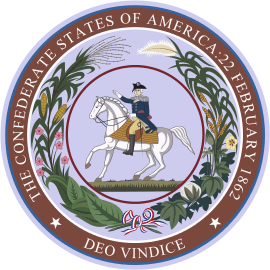 |
|
Confederate States in the American Civil War |
|---|
|
|
| Dual governments |
| Territory |
|
Allied tribes in Indian Territory |
North Carolina had joined the Confederacy with some reluctance, mainly because neighbouring Virginia had done so, and it remained a divided state throughout the war, with the western mountain people retaining much Union sentiment. Yet it contributed more troops to the Confederacy than any other state (though it also raised Union regiments), and channelled many vital supplies through the major port of Wilmington, in defiance of the Union blockade.
Fighting occurred sporadically in the state from September 1861, when Union Major General Ambrose Burnside set about capturing key ports and cities, notably Roanoke Island and New Bern. In 1864, the Confederates assumed the offensive, temporarily reconquering Plymouth, while the Union army launched several attempts to seize Fort Fisher. Troops from North Carolina played a major role in dozens of battles, including Gettysburg, where Tar Heels were prominent in Pickett's Charge. One of the last remaining major Confederate armies, under Joseph E. Johnston, surrendered near Bennett Place to Sherman, who spared North Carolina the destruction he had inflicted on her southern neighbour.
Origins
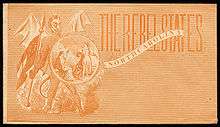
North Carolina was a picture of contrasts. In the Coastal Plain, it was a plantation state with a long history of slavery. However, there were no plantations and few slaves in the mountainous western part of the state. These differing perspectives show in the fraught election of 1860 and its aftermath. North Carolina's electoral votes went to Southern Democrat John C. Breckinridge, an adamant supporter of slavery who hoped to extend the "peculiar institution" to the United States' western territories, rather than to the Constitutional Union candidate, John Bell, who carried much of the upper South. Yet North Carolina (in marked contrast to most of the states that Breckinridge carried) was reluctant to secede from the Union when it became clear that Republican Abraham Lincoln had won the presidential election. In fact, North Carolina did not secede until May 20, 1861, after the fall of Fort Sumter and the secession of the Upper South's bellwether, Virginia.
Some white North Carolinians, especially yeoman farmers who owned few or no slaves, felt ambivalently about the Confederacy; draft-dodging, desertion, and tax evasion were common during the Civil War years, especially in the Union-friendly western part of the state. North Carolinians, often in disagreement with the aristocracy of eastern planters, raised about 25,000 troops from the western counties to fight and occupy territory in the mountain region of North Carolina and Tennessee, as well as the coastal plains of North Carolina, sometimes with troops from other states. Central and Eastern white North Carolinians were more enthusiastic about the Confederate cause; North Carolina contributed more troops to the Confederacy than any other state.[1]
Initially, the policy of the Confederate populace was to embargo cotton shipments to Europe in hope of forcing them to recognize the Confederacy's independence to resume trade. The plan failed, and furthermore the Union's naval blockade of Southern ports drastically shrunk North Carolina's international commerce via shipping. Internally, the Confederacy had far fewer railroads than the Union. The breakdown of the Confederate transportation system took a heavy toll on North Carolina residents, as did the runaway inflation of the war years and food shortages in the cities. In the spring of 1863, there were food riots in Salisbury.[2]
Although there was little military combat in the Western districts, the psychological tensions grew greater and greater. Historians John C. Inscoe and Gordon B. McKinney argue that in the western mountains:
- Differing ideologies turned into opposing loyalties, and those divisions eventually proved as disruptive as anything imposed by outside armies....As the mountains came to serve as refuges and hiding places for deserters, draft dodgers, escaped slaves, and escaped prisoners of war, the conflict became even more localized and internalized, and at the same time became far messier, less rational, and more mean-spirited, vindictive, and personal.[3]Western
Campaigns in North Carolina
From September 1861 until July 1862, Union Major General Ambrose Burnside, commander of the Department of North Carolina, formed the North Carolina Expeditionary Corps and set about capturing key ports and cities. His successes at Battle of Roanoke Island and Battle of New Bern helped cement Federal control of a part of coastal Carolina.
Fighting continued in North Carolina sporadically throughout the war. In 1864, the Confederates assumed the offensive in North Carolina, trying to recover some of the territory lost to Burnside's expedition. They failed to retake New Bern, but reconquered Plymouth and held it for 6 months. Moreover, the Union army launched several attempts to seize Fort Fisher. In the war's closing days, a large Federal force under General Sherman marched into North Carolina, and in a series of movements that became known as the Carolinas Campaign, occupied much of the state and defeated the Confederates in several key battles, including Averasborough and Bentonville. The surrender of General Joseph E. Johnston's Confederate army at Bennett Place in April 1865 essentially ended the war in the Eastern Theater.
Battles in North Carolina
- Battle of Albemarle Sound
- Battle of Averasborough
- Battle of Bentonville
- Battle of Fort Anderson
- Battle of Fort Fisher I
- Battle of Fort Fisher II
- Siege of Fort Macon
- Battle of Goldsboro Bridge
- Battle of Hatteras Inlet Batteries
- Battle of Kinston
- Battle of Monroe's Cross Roads
- Battle of Morrisville
- Battle of New Bern
- Battle of Plymouth
- Battle of Roanoke Island
- Battle of South Mills
- Battle of Tranter's Creek
- Battle of Washington
- Battle of White Hall
- Battle of Wilmington
- Battle of Wyse Fork
Notable Confederate leaders from North Carolina
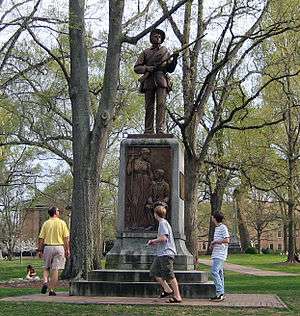

General
Braxton Bragg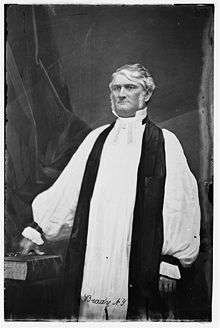
Lt. Gen.
Leonidas Polk
Maj. Gen.
D. H. Hill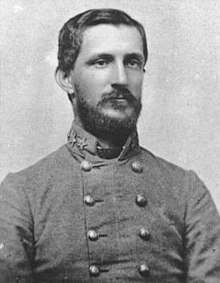
Maj. Gen.
Robert F. Hoke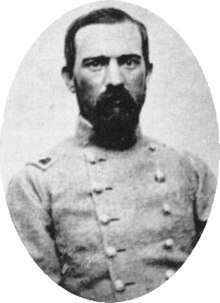
Maj. Gen.
Dorsey Pender
Maj. Gen.
Stephen Dodson Ramseur
Brig. Gen.
George B. Anderson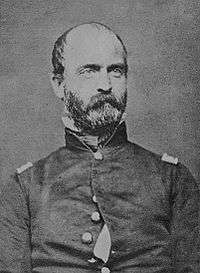
Brig. Gen.
Lewis A. Armistead
Brig. Gen.
Rufus Barringer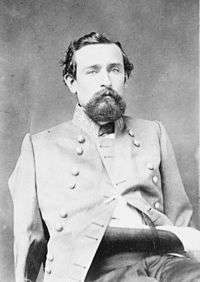
Brig. Gen.
Laurence S. Baker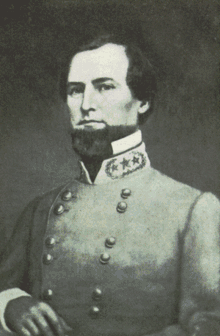
Brig. Gen.
Lawrence O. Branch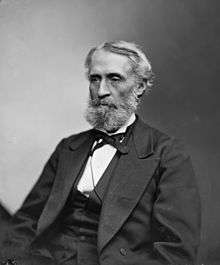
Brig. Gen.
Thomas Lanier Clingman
Brig. Gen.
William Ruffin Cox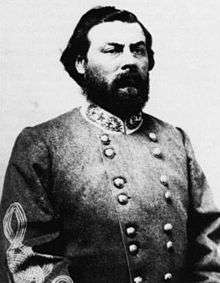
Brig. Gen.
Junius Daniel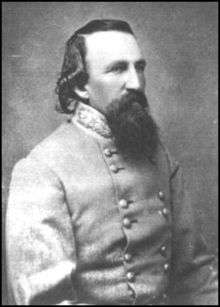
Brig. Gen.
James B. Gordon
Brig. Gen.
Bryan Grimes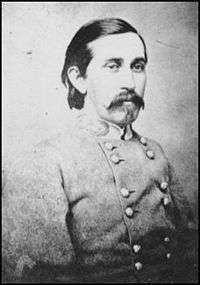
Brig. Gen.
Robert D. Johnston
Brig. Gen.
William W. Kirkland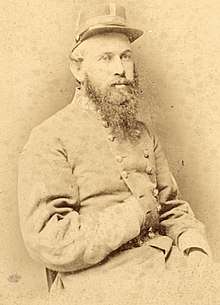
Brig. Gen.
James H. Lane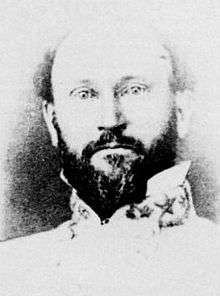
Brig. Gen.
James Green MartinBrig. Gen.
J. Johnston Pettigrew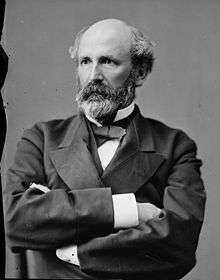
Brig. Gen.
Matt W. Ransom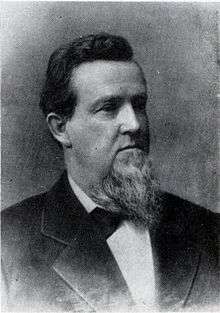
Brig. Gen.
Alfred M. Scales
Government and politics
Henry Toole Clark served as the state's governor from July 1861 to September 1862. Clark founded a Confederate prison in North Carolina, set up European purchasing connections, and built a successful gunpowder mill. His successor Zebulon Vance further increased state assistance for the soldiers in the field. As the war went on, William Woods Holden became a quiet critic of the Confederate government, and a leader of the North Carolina peace movement. In 1864, he was the unsuccessful "peace candidate" against incumbent Governor Vance.[4] Unionists in North Carolina formed a group called the "Heroes of America" that was allied with the U.S. Numbering nearly 10,000 men, a few of them possibly black, they helped Southern Unionists escape to U.S. lines.[5]
See also
- List of North Carolina Confederate Civil War units
- List of North Carolina Union Civil War regiments
- Category:Confederate States of America monuments and memorials in North Carolina
References
- ↑ John C. Inscoe and Gordon B. McKinney (2003). The Heart of Confederate Appalachia: Western North Carolina in the Civil War. Univ of North Carolina Press. p. 9.
- ↑ Brooks D. Simpson (2013). The Civil War: The Third Year Told by Those Who Lived It: (Library of America #234). Library of America. p. 193.
- ↑ John C. Inscoe and Gordon B. McKinney (2003). The Heart of Confederate Appalachia: Western North Carolina in the Civil War. Univ of North Carolina Press. p. 9.
- ↑ R. Matthew Poteat (2009). Henry Toole Clark: Civil War Governor of North Carolina. McFarland. pp. 90–118.
- ↑ Foner, Eric (March 1989). "The South's Inner Civil War: The more fiercely the Confederacy fought for its independence, the more bitterly divided it became. To fully understand the vast changes the war unleashed on the country, you must first understand the plight of the Southerners who didn't want secession". American Heritage. Vol. 40 no. 2. American Heritage Publishing Company. p. 3. Archived from the original on January 3, 2015. Retrieved December 18, 2013.
Further reading
- Barrett, John G. The Civil War in North Carolina. (University of North Carolina Press, 1963).
- Barrett, John Gilcrest. The Civil War in North Carolina. (North Carolina Department of Cultural Resources, 1984).
- Carbone, John S. The Civil War in Coastal North Carolina. (North Carolina Division of Archives and History, 2001).
- Clinard, Karen L. and Richard Russell (eds.) Fear in North Carolina: The Civil War Journals and Letters of the Henry Family. (Winston-Salem, NC: John F. Blair Publishing, 2008).
- Erslev, Major Brit K. Taming the Tar Heel Department: DH Hill and the Challenges of Operational-Level Command during the American Civil War (Pickle Partners Publishing, 2015).
- Hardy, Michael C. North Carolina in the Civil War. The History Press, 2011.
- Inscoe, John C. and Gordon B. McKinney. The Heart of Confederate Appalachia: Western North Carolina in the Civil War. (University of North Carolina Press, 2000).
- McSween, Murdoch John. Confederate Incognito: The Civil War Reports of" Long Grabs," aka Murdoch John McSween, 26th and 35th North Carolina Infantry (McFarland, 2012).
- Mobley, Joe A. Confederate Generals of North Carolina: Tar Heels in Command (Arcadia Publishing, 2012).
- Myers, Barton A. Rebels Against the Confederacy: North Carolina's Unionists. (Cambridge University Press, 2014).
- Poteat, R. Matthew (2009). Henry Toole Clark: Civil War Governor of North Carolina. McFarland. pp. 90–118.
- Reid, Richard M. Freedom for Themselves: North Carolina's Black Soldiers in the Civil War Era. (University of North Carolina Press, 2008).
External links
| Preceded by Arkansas |
List of C.S. states by date of admission to the Confederacy Admitted on May 20, 1861 (10th) |
Succeeded by Tennessee |
.svg.png)
.jpg)

